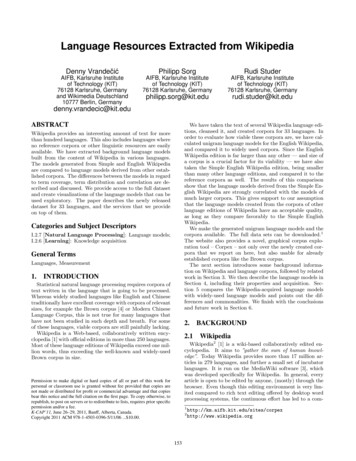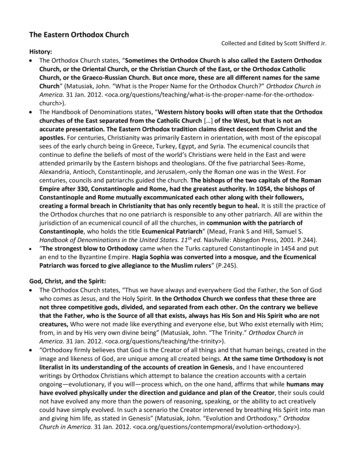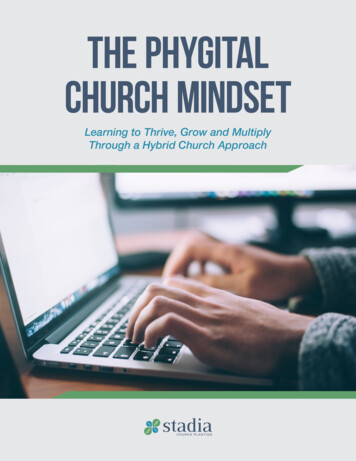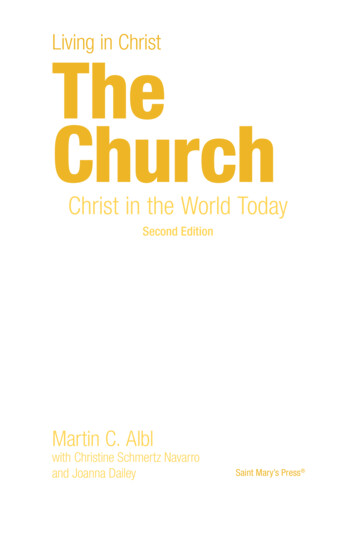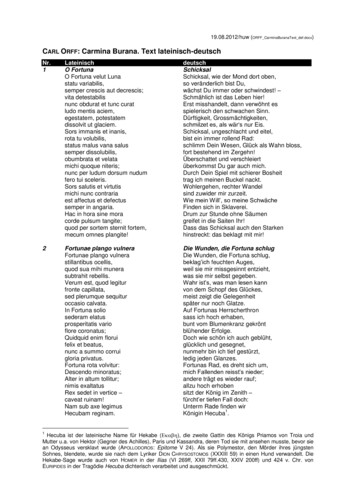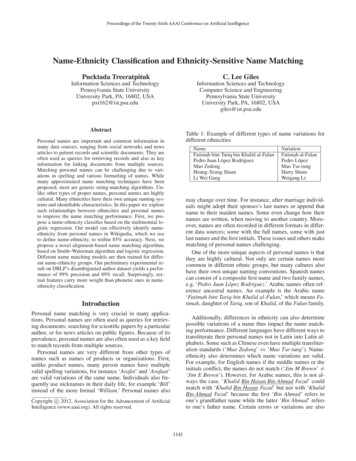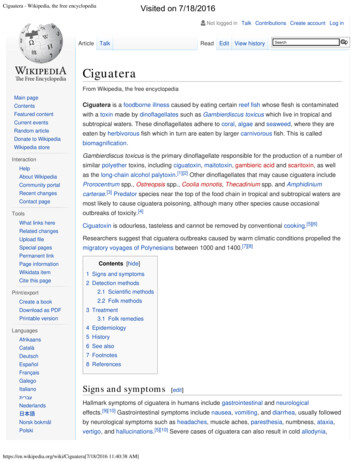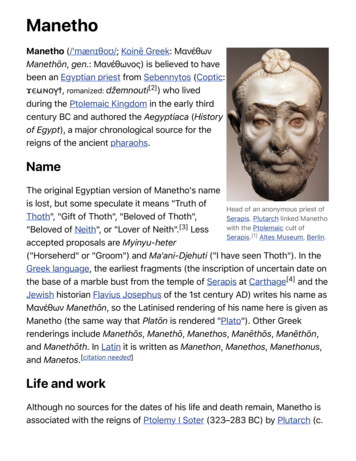
Transcription
ManethoManetho (/ˈmænɪθoʊ/; Koinē Greek: ΜανέθωνManethōn, gen.: Μανέθωνος) is believed to havebeen an Egyptian priest from Sebennytos (Coptic:ϫⲉⲙⲛⲟⲩϯ, romanized: džemnouti[2]) who livedduring the Ptolemaic Kingdom in the early thirdcentury BC and authored the Aegyptiaca (Historyof Egypt), a major chronological source for thereigns of the ancient pharaohs.NameThe original Egyptian version of Manetho's nameis lost, but some speculate it means "Truth ofHead of an anonymous priest ofThoth", "Gift of Thoth", "Beloved of Thoth",Serapis. Plutarch linked Manethowith the Ptolemaic cult of"Beloved of Neith", or "Lover of Neith".[3] LessSerapis.[1] Altes Museum, Berlin.accepted proposals are Myinyu-heter("Horseherd" or "Groom") and Ma'ani-Djehuti ("I have seen Thoth"). In theGreek language, the earliest fragments (the inscription of uncertain date onthe base of a marble bust from the temple of Serapis at Carthage[4] and theJewish historian Flavius Josephus of the 1st century AD) writes his name asΜανέθων Manethōn, so the Latinised rendering of his name here is given asManetho (the same way that Platōn is rendered "Plato"). Other Greekrenderings include Manethōs, Manethō, Manethos, Manēthōs, Manēthōn,and Manethōth. In Latin it is written as Manethon, Manethos, Manethonus,and Manetos.[citation needed]Life and workAlthough no sources for the dates of his life and death remain, Manetho isassociated with the reigns of Ptolemy I Soter (323–283 BC) by Plutarch (c.
46–120 AD) and according to George Syncellus Manetho links himselfdirectly with Ptolemy II Philadelphus (285–246 BC).If the mention of someone named Manetho inthe Hibeh Papyri, dated to 241/240 BC, is infact the celebrated author of the Aegyptiaca,then Manetho may well have been workingduring the reign of Ptolemy III Euergetes (246–222 BC) as well but at a very advanced age.Though the historicity of Manetho ofSebennytus was taken for granted by Josephusand later authors the question as to whether heactually existed remains problematic. TheManetho of the Hibeh Papyri has no title andthis letter deals with affairs in Upper Egypt notLower Egypt where our Manetho is thought to Ptolemy Philadelphus in the Libraryhave functioned as a chief priest. The nameof Alexandria, by VincenzoManetho is rare but there is no reason a priori Camuccini (1813). Manetho linkshimself directly to Pharaoh Ptolemyto assume that the Manetho of the HibehII.Papyri is the historian from Sebennytus who isthought to have authored the Aegyptiaca for Ptolemy Philadelphus.Manetho is described as a native Egyptian and Egyptian would have beenhis mother tongue. Though the topics he supposedly wrote about dealt withEgyptian matters, he is said to have written exclusively in the Greeklanguage for a Greek-speaking audience. Other literary works attributed tohim include Against Herodotus, The Sacred Book, On Antiquity andReligion, On Festivals, On the Preparation of Kyphi, and the Digest ofPhysics. The treatise Book of Sothis has also been attributed to Manetho. Itis important to note that not one of these works are actually attested duringthe Ptolemaic period when Manetho of Sebennytus is said to have lived. Infact, they are not mentioned in any source prior to the 1st century AD. Thiswould be a gap of three centuries between the time the Aegyptiaca was
supposedly composed and its first attestation. The gap is even larger forthe other works attributed to Manetho such as The Sacred Book which ismentioned for the very first time by Eusebius in the 4th century AD.[5]If Manetho of Sebennytus was an historical figure he was probably a priestof the sun-god Ra at Heliopolis (according to George Syncellus, he was thechief priest). He was considered by Plutarch to be an authority on the cultof Serapis (a derivation of Osiris and Apis). Serapis itself was a GrecoMacedonian version of the Egyptian cult, probably started after Alexanderthe Great's establishment of Alexandria in Egypt. A statue of the god wasimported in 286 BC by Ptolemy I Soter (or in 278 BC by Ptolemy IIPhiladelphus) as Tacitus and Plutarch attest.[6] There was also a tradition inantiquity that Timotheus of Athens (an authority on Demeter at Eleusis)directed the project together with Manetho, but the source of thisinformation is not clear and it may originate from one of the literary worksattributed to Manetho, in which case it has no independent value and doesnot corroborate the historicity of Manetho the priest-historian of the early3rd century BC.AegyptiacaManetho is believed to have authored the Aegyptiaca (Αἰγυπτιακά, genitiveΑἰγυπτιακῶν)[7]), or History of Egypt, at the request of Ptolemy IIPhiladelphus.[8] The work is of great interest to Egyptologists for evidenceof the chronology of the reigns of the ancient Pharaohs. It may have beenthe largest of all the works attributed to Manetho, and it is certainly themost important. It was organised chronologically and divided into threebooks (see below). The division of rulers into dynasties was an innovation.The term "dynasty" (Greek: δυναστεία dynasteía, abstractly meaning"governmental power") is employed to refer to a group of kings with acommon origin. Thus, the author did not use the term in the modern sense,by bloodlines, but rather, introduced new dynasties whenever he detectedsome sort of discontinuity whether geographical (Dynasty IV from
Memphis, Dynasty V from Elephantine), or genealogical (especially inDynasty I, the author sometimes refers a successive pharaoh as the "son"of the previous to define what he means by "continuity"). Within thesuperstructure of a genealogical table, he fills in the gaps with substantialnarratives of the Pharaonic kings. Some have suggested that Aegyptiacawas written as a competing account to Herodotus' Histories, to provide anational history for Egypt that did not exist before. From this perspective,Against Herodotus may have been an abridged version or just a part ofAegyptiaca that circulated independently. Unfortunately, neither survives inits original form.Authorship and date ofcompositionThe earliest known mention of theAegyptiaca is by the Jewish historianJosephus in his work Contra Apionem("Against Apion"), which can be datedafter AD 94. Before this, no writerThe transmission of the manethonian text.whose work survives mentions theAegyptiaca in at least 300 years; this raises a serious question andlegitimate doubt as to its real date and authorship. The notion that anofficial and authoritative history of Egypt composed in Greek at the requestof Ptolemy II Philadelphus could go unnoticed or ignored by severalprofessional scholars and Alexandrian librarians for centuries until Josephusis hardly credible. The work may have instead been written in the Romanperiod and not that long before it is first mentioned. If so, the real author,who some scholars speculate was the historian Ptolemy of Mendes,[9] aneducated Greek who was born and raised in Egypt and became a priest,may have attributed the contents of the three-volume history to Manetho inorder to give the work credibility. According to Clement of Alexandria (c. 150– c. 215 AD), Ptolemy of Mendes composed a history of Egypt in threebooks, during the time of emperor Augustus.[10] Clement cites numerous
authors in his writings and he had access to the library of Alexandria but henever mentions Manetho or Manetho's history in three books. The samemay be said for Tatian (c. 120 – c. 180 AD), another extremely well readChristian author of the 2nd century AD. In his Oratio ad Graecos (Address tothe Greeks), Tatian mentions only Ptolemy of Mendes as "the interpreter oftheir [Egyptian] affairs." He mentions virtually every writer who touchedupon his subjects of interest, such as historical chronology, but no directmention of Manetho is ever made. Tatian writes:Of the Egyptians also there are accurate chronicles. Ptolemy, not theking, but a priest of Mendes, is the interpreter of their affairs. This writer,narrating the acts of the kings, says that the departure of the Jews fromEgypt to the places whither they went occurred in the time of kingAmosis, under the leadership of Moses. He thus speaks: "Amosis lived inthe time of king Inachus." After him, Apion the grammarian, a man mosthighly esteemed, in the fourth book of his Aegyptiaca (there are fivebooks of his), besides many other things, says that Amosis destroyedAvaris in the time of the Argive Inachus, as the Mendesian Ptolemy wrotein his annals.[11]The name Amosis (Άµωσις) is the Greek rendering of the royal Egyptianname of Ahmose and it was used for the first king of the 18th Dynasty in theedition of the Aegyptiaca that Eusebius consulted in order to make hisepitome of the work.[12] According to Tertullian (c. 155 – c. 240 AD),Ptolemy of Mendes wrote later than and "followed" Manetho.[13] Thisstatement has usually been taken to mean that Ptolemy of Mendesconsulted and commented on Manetho in his writings. It may also meanthat Ptolemy of Mendes is responsible for everything we currently think weknow about Manetho. It is very unlikely that Tatian, Apion, and Clement wereunaware of Manetho's history in three books, but according to Tatian Apionread and followed Ptolemy of Mendes when he wrote his own history ofEgypt in five books. Hence it may be plausibly suggested that Tatian, Apion,and Clement all understood that Ptolemy of Mendes was the actual
composer of the work entitled the Aegyptiaca in three books and thatPtolemy of Mendes claimed to be the transmitter of Manetho's words. Inthis case the work was not an anonymous or pseudonymous work, but onewherein Ptolemy of Mendes explicitly claimed he was reproducing thewords of an important Egyptian high priest who lived three centuries earlier.The above theory of authorship and date of composition is furthersupported by a confusion in the Suda, a massive Byzantine encyclopediamade during the 10th century. According to the Suda, there were twoauthors named Manetho: one from Mendes and one from either Sebennytusor Diospolis (Thebes). Yet the Suda does not attribute the Aegyptiaca toeither one. The Mendesian Manetho wrote about the preparation of kyphi,while the Manetho of Sebennytus or Diospolis wrote "Enquiries into Nature;Apotelesmatica in verse; and other astrological works." The Suda mentionsauthors who composed works in Greek during the time of Ptolemy IIPhiladelphus (such as the comic poet Aristonymos) but does not includeManetho. Hence the most that can be said is that the author of the Sudaconfused Ptolemy of Mendes with Manetho of Sebennytus and that he didnot agree with the story repeated by Syncellus that the Aegyptiaca dates tothe time of Ptolemy II Philadelphus in the 3rd century BC. The work is firstattested in the Roman period. Nor are any of the other literary works inGreek that have been attributed to Manetho ever attested during thePtolemaic period.Content and StructureBook 1 of Manetho's history began with an introduction or preamble thatundoubtedly gave a brief biography of Manetho and stated the purpose forwriting the work. In the preamble the author stated that the first Hermeswho is identified as the god Thoth invented writing.[14] The writings of thisfirst Hermes were then translated into a new script called hieroglyphics byhis son Hermes Trismegistus who is the second Hermes. The books writtenby this second Hermes were later collected and arranged by his son, the
god Agathodaemon. According to the author, Agathodaemon only finishedhis editorial work of arranging the "sacred books" written by his fatherHermes Trismegistus after the accession of Ptolemy Philadelphus. It wasonly at this point that Manetho was given access to these sources and thenhe utilized them to write his own detailed history of Egypt in Greek for thereigning Ptolemaic king. Syncellus writes:In the time of Ptolemy Philadelphus he was styled high-priest of thepagan temples of Egypt, and wrote from inscriptions in the Seriadic land,traced, he says, in sacred language and holy characters by Thoth, thefirst Hermes, and translated [by the second Hermes] in hieroglyphiccharacters. When the work had been arranged in books byAgathodaemon, son of the second Hermes and father of Tat, in thetemple-shrines of Egypt, Manetho dedicated it to the above KingPtolemy II Philadelphus in his Book of Sothis .[15]Deities mentioned by Manetho in his preambleThoth — from the ramesside Temple of Abydos.Hermes — Capitoline Museums, Rome.Hermes Trismegistus — from the Siena Cathedral.Agathodaemon — Altes Museum, Berlin.By Book of Sothis Syncellus must mean the Aegyptiaca by another title, forthe actual Book of Sothis does not discuss the mythic reigns of the gods,demigods, and the spirits of the dead. Nor does it group the kings of Egyptinto thirty dynasties as Syncellus says the Book of Sothis does. It appearsSyncellus preferred to call Manetho's Aegyptiaca by the alternative titleBook of Sothis but the reasons are not clear. A close study of the material inthe actual Book of Sothis reveals that its author relied upon but intentionallydeviated from the Aegyptiaca and is likely a forgery or hoax of unknown
date. Every king in the Book of Sothis after Menes is irreconcilable with theversions of Africanus and Eusebius.Despite this confusion caused by Syncellus, the inferences being made inthe preamble of the Aegyptiaca are nonetheless clear: the accession ofPtolemy II Philadelphus was considered by the author to be a major turningpoint in Egypt's history because it was only during this king's reign that thegod Agathodaemon completed editing the "sacred books," and this was aprerequisite for Manetho to compose a history of Egypt in Greek. The chainof cultural transmission spans three generations of gods (Thoth, HermesTrismegistus, and Agathodaemon) to the priest Manetho and the Greekscript is now on a par with the hieroglyphs. Greek has now become thelanguage and script through which Egypt's entire history is to be officiallyrecorded in three books for Ptolemy II Philadelphus. It is as if the goal ofEgyptian civilization was that it was destined to become the property ofGreek civilization and be eclipsed by Hellenism. The author depictsManetho as having helped facilitate this transfer in a most significant wayby translating the contents of the "sacred books" of supernaturalauthorship into Greek, something which had not been done in any of thelanguages spoken by the various foreigners who dominated Egypt beforethe Greek conquest. Greek is now Egypt's new language and divinelyordained for translating the hieroglyphic writings of the god HermesTrismegistus.After this the author reproduces a letter supposedly written by Manetho toPtolemy II Philadelphus:To the great King Ptolemy Philadelphus Augustus. Greeting to my lordPtolemy from Manetho, high-priest and scribe of the sacred shrines ofEgypt, born at Sebennytus and dwelling at Heliopolis. It is my duty,almighty king, to reflect upon all such matters as you may desire me toinvestigate. So, as you are making researches concerning the future ofthe universe, in obedience to your command I shall place before you the
sacred books which I have studied, written by your forefather, HermesTrismegistus. Farewell, I pray, my lord King.[16]The letter is obviously a forgery, because in it Manetho addresses PtolemyPhiladelphus with the title Augustus, which was not used for Ptolemaickings. This slip of the pen allows one to determine the terminus post quemor earliest possible date of composition, which is the reign of emperorAugustus (28 BC-AD 14) when Ptolemy of Mendes was active. After thisletter the author proceeded to discuss the earliest times in Egypt, listing thereigns of the gods and demigods and the spirits of the dead as kings ofEgypt. There were seven god-kings, then four lines of demigods, and thenthe spirits of the dead (evidently another type or different class ofdemigods) but the number and their names are not preserved in thefragmenta.GODS[17]Hephaestus (Ptah)Helios (son of Hephaestus)Sosis (Shu)CronusOsirisTyphonOrus (son of Osiris and Isis)Total: 13,900 yearsDEMIGODSDemigods for 1255 yearsDemigods for 1817 years30 Demigods of Memphis for 1790 yearsDemigods of This (Thinis) for 350 years
Total: 5,212 yearsSPIRITS OF THE DEADSpirits of the dead for 5,813 yearsTotal: 5,813 yearsTotal for gods, demigods, and spirits of the dead: 24,925 yearsThe author does not transliterate the names of the gods, demigods, or thespirits of the dead but gives the Greek equivalents by a convention thatpredates him: (Egyptian) Ptah (Greek) Hephaestus; Ra Helios; Shu, sonof Ra Sosis; Geb Chronos; Asar Osiris; Isis Demeter; Set Typhon;Horus Orus; Thoth the first Hermes; etc. Stories about each of thesegods, and possibly others, most likely would have been found here. This isone of the clues as to how syncretism developed between seeminglydisparate religions.As for the dynasties that followed the spirits of the dead, the author statesthat Egypt was ruled by five native or indigenous Egyptian tribes, andfurther that the country was ruled by a total thirty mortal dynasties (but insubsequent editions the number is thirty-one) prior to the Greek conquestby Alexander the Great. Book One discussed the first eleven dynasties:Dynasties I–XI. These dynasties fall into the periods of Egyptian historyEgyptologists refer to as the Old Kingdom, the First Intermediate Period,and the early Middle Kingdom.Book 2 covered Dynasties XII–XVIII in the first edition which grouped thekings of Dynasty XIX in with Dynasty XVIII. Book Two discussed the end ofthe Middle Kingdom and the Second Intermediate Period, the Hyksosinvasion, and then their expulsion and the establishment of the NewKingdom by Ahmose I, the founder of Dynasty XVIII. This dynasty, in thefirst edition of the work, would have ended with Thouoris (Egyptian:
Twosret, Twosre, or Tausret) who is erroneously mistaken by the author forbeing a male king and the same person as the Polybus of Thebesmentioned by Homer (Odyssey IV, 126). The author dates the fall of Troy tothe reign of Thouoris.Book Two was also of particular interest toJosephus, where he equated the Hyksos or"shepherd-kings" with the ancient Israelites whomade their exodus out of Egypt (Apion 1.82–92).Josephus even includes a brief etymologicaldiscussion of the word "Hyksos" by noting thatthe term is defined differently by Manetho in theconflicting editions of his history. Josephusfavored Manetho's "captive shepherds" (Apion1.91), apparently from the first edition, over his"shepherd-kings" (Apion 1.82-83) in thesubsequent second and third editions. Evidentlyin the first edition the Hyksos were suspected by Queen Twosret (c. 1191–1189BC), erroneously mistaken bythe author of being invaders from Arabia, but in Manetho for being the homericthe second and third editions they are confidently Polybus of Thebes.identified as Phoenicians (i.e. Canaanites).According to Manetho, they were the builders of Jerusalem (previouslyknown as Salem) after their expulsion from Egypt. This tradition maysuggest that the Hyksos were the same as the Jebusites (a Canaanite tribe)of the biblical record.Book Two also included the Leper Story, at least in the earliest edition,which Josephus quoted and criticized at considerable length.[18] TheEgyptian grammarian Apion (BC 30-20 – c. 45-48 AD) knew a modifiedversion of this story but he dated the episode not to the New Kingdom butto the first year of the 7th Olympiad (i.e. 752 BC).[19] Since it is difficult tobelieve Apion would contradict "Manetho" it is reasonable to assume thatthe author of the Aegyptiaca revised this tale and moved it into the reign of
one of the kings listed in Book Three in the subsequent editions of his work.Apion would thus have been relying upon the revised second or third editionof the Aegyptiaca for the Leper Story and his dating the episode to the 8thcentury BC.Book 3 continued with the "XIXth dynasty" of Egypt (i.e. Dynasty XX in thesecond and third editions) and concludes with the "XXXth dynasty" (i.e.Dynasty XXXI in the second and third editions). The Saite Renaissanceoccurs in the "XXVth dynasty" (i.e. Dynasty XXVI), while the "XXVIthdynasty" (i.e. Dynasty XXVII) involves the Persian Anshanite rule ofCambyses and then Barziya, sons of Cyrus the Great. Barziya wasdenounced as a Magian (the Magians were a tribe of Medes) fraud by hissuccessor who overthrew him and the author accepted this charge andchose to call him simply Magi.[20] This king is omitted altogether in theauthor's third edition which Africanus used.[21] The Persian Achaemenidregime of Darius Hystaspes and his descendants follow. Three more localdynasties are mentioned, though they must have overlapped with Persianrule despite the sequential order in Manetho. The "XXXth dynasty"consisted of three more Persian rulers, and some have suggested thisdynasty was added to Manetho's history by a later editor. Both Moses ofChorene and Jerome end at Nectanebo II ("last king of the Egyptians" and"destruction of the Egyptian monarchy" respectively), but the PersianDynasty XXX XXXI fits within the author's schemata of narrating Egyptianhistory from the earliest times down through the dynasteia to the eve of theGreek supremacy and is most likely original.The numbering system for the dynasties used in the first edition wasrevised by the author in subsequent editions but he almost certainlyconcluded Book Three with Darius III. He also mentioned the capture andexecution of Darius III by Alexander the Great,[22] but this was an error onthe author's part and removed by him in the final edition.[23]Three editions of this work by a single author is further evidenced in the
names given to the founder of Dynasty XVIII. In the first edition his name iserroneously and curiously called Tethmosis (Τέθµωσις).[24] In the secondedition the author revised this to Amosis (Άµωσις).[25] Finally, in his thirdedition he corrected this to Amos (Άµως)[26] which is the most accurate ofall three Greek renderings of the name Ahmose in ancient Egyptian.For more exact composition dates, if 28 BC is taken as the earliest datepossible for the first edition then the second and third editions wereprobably made in ca. 18 BC and ca. 8 BC, respectively. These dates can bebacked up by the story of the oracular prophetic lamb. According to aDemotic text dated to the reign of emperor Augustus a "talking lamb" in thetime of Bocchoris (Egyptian: Bakenranef) predicted a 990-year period ofhardships in Egypt following an invasion from Assyria. It is possible thisstory has much older antecedents but positing a 300-year gap in the recordwould not be erring on the side of caution. One should rather argue that thecomposition of the Aegyptiaka of Manetho and its subsequent revisionswere made by a single author during the lengthy reign of emperorAugustus. This author, who is very likely to be Ptolemy of Mendes, evidentlyclaimed he was reproducing the words of a high priest named Manetho ofSebennytus who supposedly lived three centuries earlier and wrote at therequest of Ptolemy II Philadelphus.Transmission and receptionThe greatest problem with a close study of Manetho's history, despite thereliance of Egyptologists on him for their reconstructions of the Egyptiandynasties, is that not only was the Aegyptiaca not preserved as a whole, butit is believed to have become involved in a rivalry between advocates ofEgyptian, Jewish, and Greek histories in the form of supporting polemics,although there is actually no direct evidence for this. It is however true thatduring this period disputes raged concerning the oldest civilizations, and soManetho's history was probably excerpted during this time for use in thisargument. Material similar to what has been attributed to Manetho's has
been found in Lysimakhos of Alexandria, a brother of Philo, and it has beensuggested that this material may have been modified and inserted intoManetho. Again this suggestion is without any real evidence to support it.As mentioned, the earliest attestation of Manetho's writings is found inJosephus' Contra Apionem ("Against Apion") nearly three centuries afterthe history of Egypt was supposedly commissioned by Ptolemy IIPhiladelphus. Even here, it is clear Josephus knew and consulted differenteditions of the same work and he constructed a polemic against Manethoby exploiting some of these differences. For example, the earliest edition ofthe work did not treat the kings of Dynasty XVIII and Dynasty XIX as twoseparate regimes but as one dynasty. Apion 1.95–97 is a list of kings with nonarratives until 1.98, while running across these two dynasties without anyhint of a break. Josephus accuses Manetho for interpolating a fictitious kingin this dynasty named Amenophis (Άµένωφις), fictitious because he is listedimmediately after the 66-year reign of Ramesses II (Ραµψής) but Manethodid not give him a reign length, which is something he did for every otherking. Even if this king is the same Manetho's Ammenephthis in XIX.3 who iscredited with 40 years of reign in the edition Eusebius used and 20 years inthe edition Africanus used, Josephus seems to have a legitimate point thatinconsistencies between the various editions cast doubt on the validity ofthe Leper Story.After Josephus wrote, an epitome or summary ofManetho's history was made by Sextus JuliusAfricanus in the 3rd century. Eusebius ofCaesarea later made his own summary as well,but he used a version of the work that differedfrom the one Africanus used. Both summariesinvolved preserving the outlines of the"Manethonian" dynasties and a few detailsdeemed significant. For the first ruler of the firstDynasty, Menes, we learn that "he was snatched
Eusebius of Caesarea († 339/340and killed by a hippopotamus". The extent toAD) summarized Manetho'swhich the epitome preserved the author's original work.writing is unclear, so caution must be exercised.The version of the epitome in Africanus is usually considered more reliablethan the one made by Eusebius, but there is no assurance that this isalways the case. Eusebius in turn was preserved by Jerome in his Latintranslation, an Armenian translation, and by George Syncellus. Syncellusrecognized the similarities between Eusebius and Africanus, so he placedthem side by side in his work, Ecloga Chronographica. These last fourcopies are what remains of the epitome of Manetho. Other significantfragments include Malalas' Chronographia and Excerpta Latina Barbari("Excerpts in Bad Latin").Sources and methodsThe methods of the author of the Aegyptiaca, although he claims "sacredbooks" composed by the god Hermes Trismigestus were his primarysource, involved the use of king-lists to provide a structure for his history.There were precedents to his writing available in Egypt (plenty of whichhave survived to this day), and his Hellenistic and Egyptian backgroundwould have been influential in his writing. Josephus records him admittingto using "nameless oral tradition" (Apion 1.105) and "myths and legends"(Apion 1.229) for his account, and there is no reason to doubt this, asadmissions of this type were common among historians of that era. Hisfamiliarity with Egyptian legends is indisputable, but how the author cameto know Greek is more open to debate if we are dealing with a priest wholived in the early Ptolemaic period. In any case, the author must have beenfamiliar with Herodotus, and in some cases, he even attempted tosynchronize Egyptian history with Greek (for example, equating KingMemnon with Amenophis, and Armesis with Danaos). This suggests theauthor was also familiar with the Greek Epic Cycle (for which the EthiopianMemnon is slain by Achilles during the Trojan War) and the history of Argos(in Aeschylus's Suppliants). Because it is difficult to believe these could be
from the hand of a native Egyptian priest from as early as the 3rd century ithas also been suggested that they were later interpolations, particularlywhen the epitome was being written. However, if the author was really aneducated Greek from Mendes who lived and wrote in the time of Augustus(BC 28-14 AD) then we could expect him to be interested and thoroughlyfamiliar with the Greek Epic Cycle. He wrote in fluent Koinê Greek whichwould be somewhat unexpected for a native Egyptian who lived in the early3rd century BC but not for an educated Greek born in Mendes in the 1stcentury BC.King listsThe king-list that the author of the Aegyptiaca had access to is unknown tous, but of the surviving king-lists, the one most similar to his is the TurinRoyal Canon (or Turin Papyrus). The oldest source with which we cancompare to Manetho are the Old Kingdom Annals (c. 2500-2200 BC). Fromthe New Kingdom are the list at Karnak (constructed by order ofThutmose), two at Abydos (by Seti I and Ramesses II— the latter a duplicatebut updated version of the former), and the Saqqara list by the priest Tenry.The Palermo stone (25thcentury BC).The provenance of the Old Kingdom Annals isunknown, surviving as the Palermo Stone. Thedifferences between the Annals and Manetho aregreat. The Annals only reach to the fifth dynasty, butits pre-dynastic rulers are listed as the kings of LowerEgypt and kings of Upper Egypt. By contrast, Manetholists several Greek and Egyptian gods beginning withHephaistos and Helios. Secondly, the Annals giveannual reports of the activities of the kings, whilethere is little probability that Manetho would have beenable to go into such detail.The New Kingdom lists are each selective in their
listings: that of Seti I, for instance, lists seventy-six kings from Dynasties I toXIX omitting the Hyksos rulers and those associated with the hereticAkhenaten. The Saqqara list, contemporaneous with Ramesses II, has fiftyeight names, with similar omissions. If Manetho used these lists at all, hewould have been unable to get all of his information from them alone, due tothe selective n
who is identified as the god Thoth invented writing.[14] The writings of this first Hermes were then translated into a new script called hieroglyphics by his son Hermes Trismegistus who is the seco
